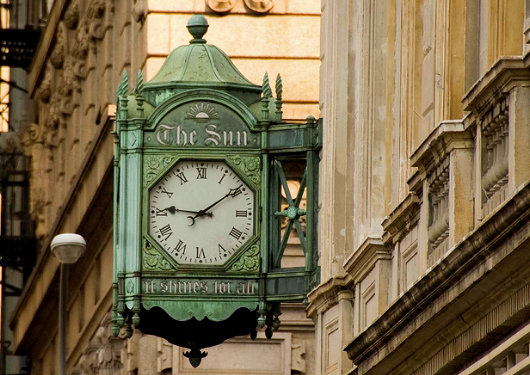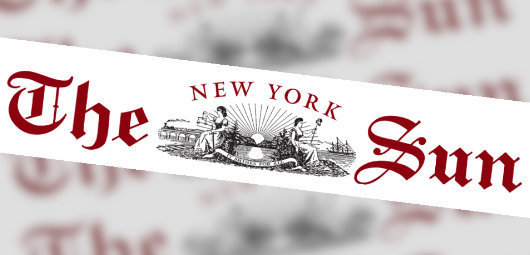
About Andrew Cusack
 Writer, web designer, etc.; born in New York; educated in Argentina, Scotland, and South Africa; now based in London.
Writer, web designer, etc.; born in New York; educated in Argentina, Scotland, and South Africa; now based in London. read more
News
Blogs
Reviews & Periodicals
Arts & Design
World
France
Mitteleuropa
Knickerbockers
Argentina
The Levant
Africa
Cape of Good Hope
Netherlands
Scandinavia
Québec
India
Muscovy
Germany
Academica
New York Sun will no longer shine for all
Center-right New York daily will cease printing at end of month

In a devastating blow to the intellectual life of the city, the New York Sun editor Seth Lipsky announced today that the small-but-influential daily newspaper will cease operations at the end of the month unless new investors can be found to put many millions of dollar into the revived title. The newspaper — known for its excellent arts & cultural coverage and willingness to lift the veil on corruption in addition to its hardcore neoconservative politics — is believed to be operating at a loss of tens of millions of dollars a year. Seth Lipsky announced the perilous state of the Sun in a letter to readers this morning:
This morning I write to you about the future of The New York Sun, which is in circumstances that may require us to cease publication at the end of September unless we succeed in our efforts to find additional financial backing. The managing editor, Ira Stoll, who is one of the founding partners in the paper, and I have shared this news with our colleagues, and we would like our readers as well to be aware of the situation.
When we launched this business in October 2001 and began publishing the daily newspaper on April 16, 2002, it was with two goals. There was an editorial — an idealistic — goal of providing an alternative to the New York Times in coverage of New York City, politics, foreign policy, and culture. And there was a financial goal of making a profit. We have always been, and still are, of the view that the paper needs to achieve both goals to be a success.
After more than six years of publication, the Sun is now at a crossroads. It has succeeded in establishing journalistic credibility and a reputation for quality and verve, and in becoming a part of the local, national, and international conversation. It is read daily by tens of thousands of New Yorkers, including the political, policy, and cultural leadership in the city. It is read in the nation’s capital — in the White House, the Congress, and in the foreign chancelleries. Newspapers and Web sites in the city and around the world follow our scoops, quote our editorials, refer to our cultural criticism, and analyze our sports coverage.
Even many who disagree with the views of our editorial page enjoy reading the Sun. “A fabulous read for culture,” is the way it was described in the Nation. David Remnick of the New Yorker sent a note to say how much he admired what we are doing with the Sun, which he called “just plain good.” He added: “OK, I agree with about ten percent of your editorials, but so what. … I’m a lot happier, and richer, for having faced the Sun in the a.m.”
This happens because we have been blessed not only with a high-quality group of readers but a wonderful staff that works extremely hard. Some have been snapped up by our competitors. The Wall Street Journal, the New York Post, the Daily News, the Washington Post, and the New York Times all employ alumni of The New York Sun. But in recent years, many of our staff members have turned down offers from competing papers to stay with a readership at the Sun we have all come to love.
There has been some success as well on the business side, where a group of loyal advertisers has awakened to our readership and made The New York Sun one of the few newspapers in America to see substantial increases in print advertising revenues not only last year and the year before but also so far this year. Yet even with those gains, the expense of producing and distributing the paper exceeds our revenues. So the Sun has yet to achieve its financial goal of making a profit.
Our losses, which are substantial, have been covered so far by a group of investors whom we would call heroic. And they are prepared to continue to back the enterprise with new capital. But as costs rise and the advertising market for newspapers generally tightens, keeping the Sun alive and moving it toward self-sufficiency will require broadening the base of investors beyond the original group.
In recent months, we have had discussions with a number of newspaper proprietors and other potential investors about possible combinations or investment relationships. Some of those are continuing. There is no assurance that any of our discussions will be successful, but we are hopeful.
We are not daunted by all the negative talk about newspapers. They have been essential institutions in our democracy throughout its history. The Boston Gazette helped inspire the American Revolution, Frederick Douglass’s North Star helped win abolition and emancipation, the Wall Street Journal helped defeat Soviet Communism.
Today the power of newspapers is on display each day as they inspire a marvelous array of bloggers and aggregation Web sites, magnifying the power of print to a degree heretofore unimagined. For us it is the honor of a lifetime to be able to appear in arms, so to speak, in a newspaper war that is alive with the battle of ideas at a juncture when ideas make all the difference.
We share all this because our community of readers reflects the dynamism and vitality and openness and positive spirit and creativity of New York and of America. We seek to capture this not only on the editorial pages but also in our cultural pages and on our front pages and in the society columns and the business and sports and health and fashion pages.
This esprit isn’t so easy to pigeonhole ideologically, and we have found that many of those who thrill to the ideas and the articles that animate The New York Sun have political beliefs for which the best label might be “unpredictable.” If there is a common thread it would be that New York’s and America’s greatest days yet lie ahead of us.
Certainly, launching this paper in the months immediately after September 11, 2001, was an optimistic project. Nearly seven years later, our editors and backers are even more of the view that there is indeed a place for the kind of intelligent, thoughtful broadsheet we envision in our city, which is why we are scrambling to find others who share this vision and the sense of possibility. If we fail, the newspaper and its voice will die. All the more energetic will be our efforts in the coming weeks to ensure that the conversation we’ve begun these past few years will continue.
Yours faithfully,
Seth Lipsky
Editor of the Sun

Figures from all walks of New York life have expressed their great concern over the fate of the Sun. Cardinal Egan said the Sun “has been a valuable addition to the New York media landscape. My day is not complete until I have had an opportunity to read the Sun. Its coverage of life in greater New York, including the world of art and culture, is first-rate. It is my sincere hope that The New York Sun will continue to grow and thrive for many years to come.”
Mayor Bloomberg expressed a hope that new investors would keep the newspaper afloat, citing “one of the great strengths of the paper” as the Sun‘s municipal coverage.
Glenn Lowry, the director of the Museum of Modern Art, said “I have been a devoted reader of the Sun‘s arts coverage for several years and have watched with great admiration as the cultural section of the paper has become one of the most important and informed sources of information about the arts in the City.”
From the realm of labor, Randi Weingarten of the teachers union said “the Sun provides an incredibly vital service in New York, and it would be terrible if it went out of business,” while Stuart Applebaum of the Central Labor Council said that for “important issues relating to city governance the first place I look is the Sun“.
The city’s legendary former mayor, Ed Koch, said The New York Sun “is the first paper I read in the morning and I have six papers that I read”. “The Sun is one of the great papers,” Mayor Koch continued, “and I hope it doesn’t disappear.”
Ben Shao, the Republic of China’s New York press director, wrote “The Sun has repeatedly offered insightful and supportive coverage of Taiwan, especially at a time when many other papers tend to disregard our country’s precarious situation. I, as well as the 23 million people in Taiwan, am deeply concerned and saddened at the prospect of losing such a distinctive and impressive voice in journalism.”

Search
Instagram: @andcusack
Click here for my Instagram photos.Most Recent Posts
- Waarburg October 2, 2024
- A Prize for the General September 23, 2024
- Articles of Note: 17 September 2024 September 17, 2024
- Equality September 16, 2024
- Rough Notes of Kinderhook September 13, 2024
Most Recent Comments
Book Wishlist
Monthly Archives
Categories


